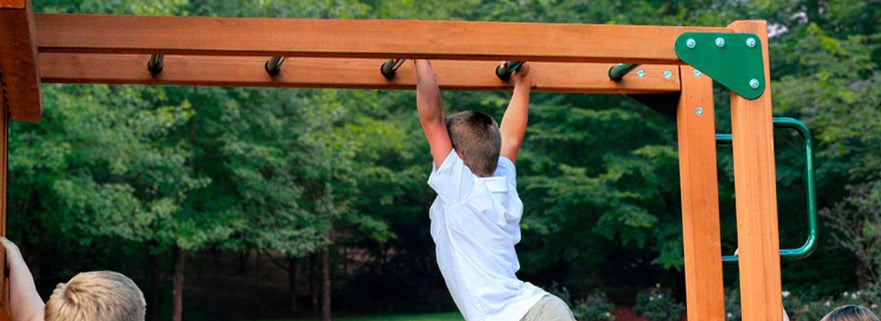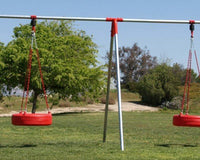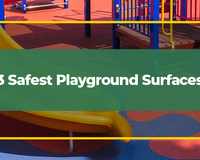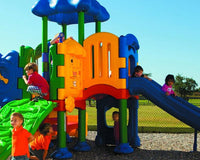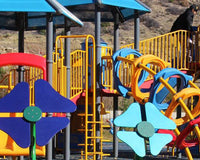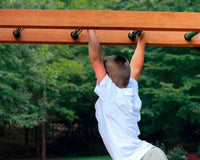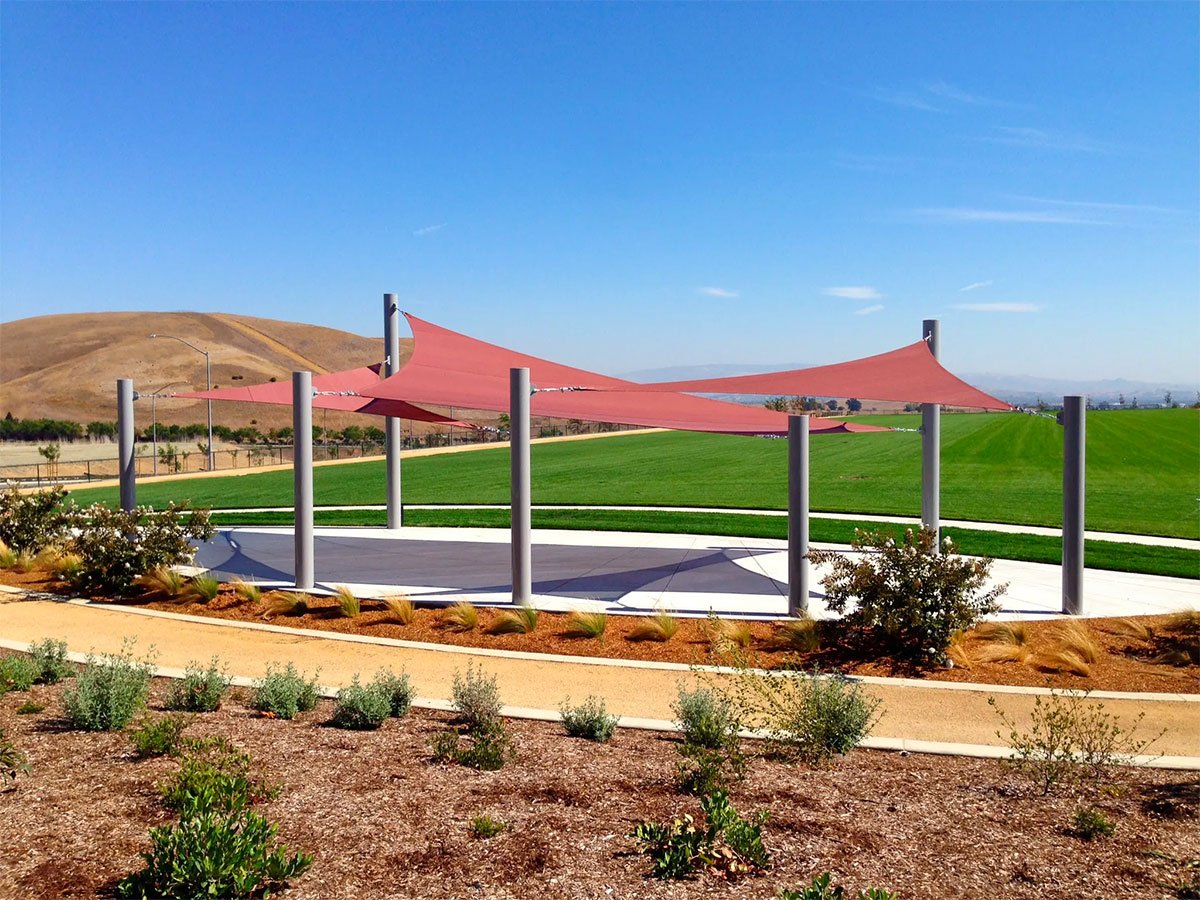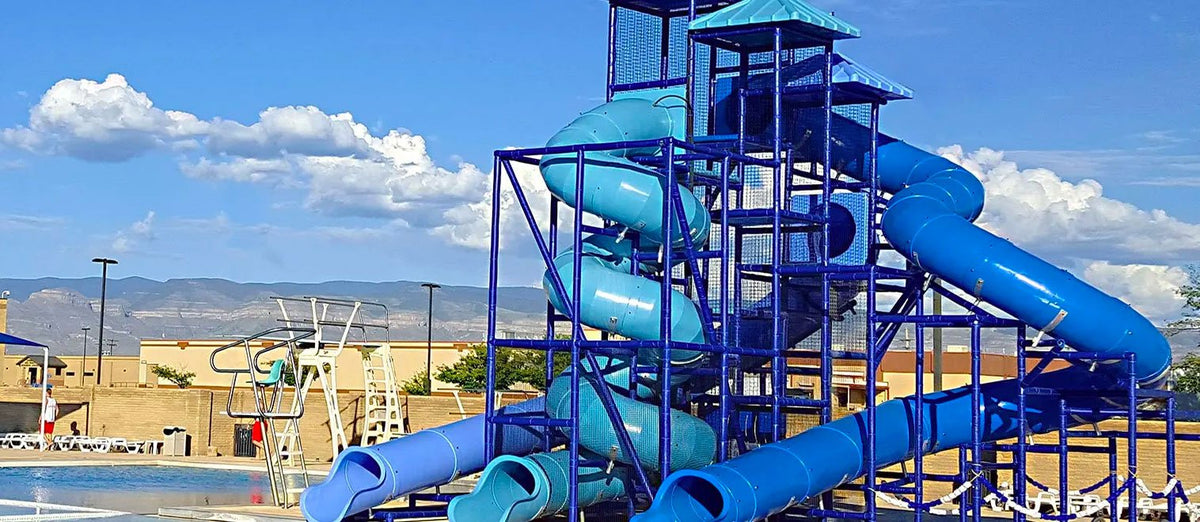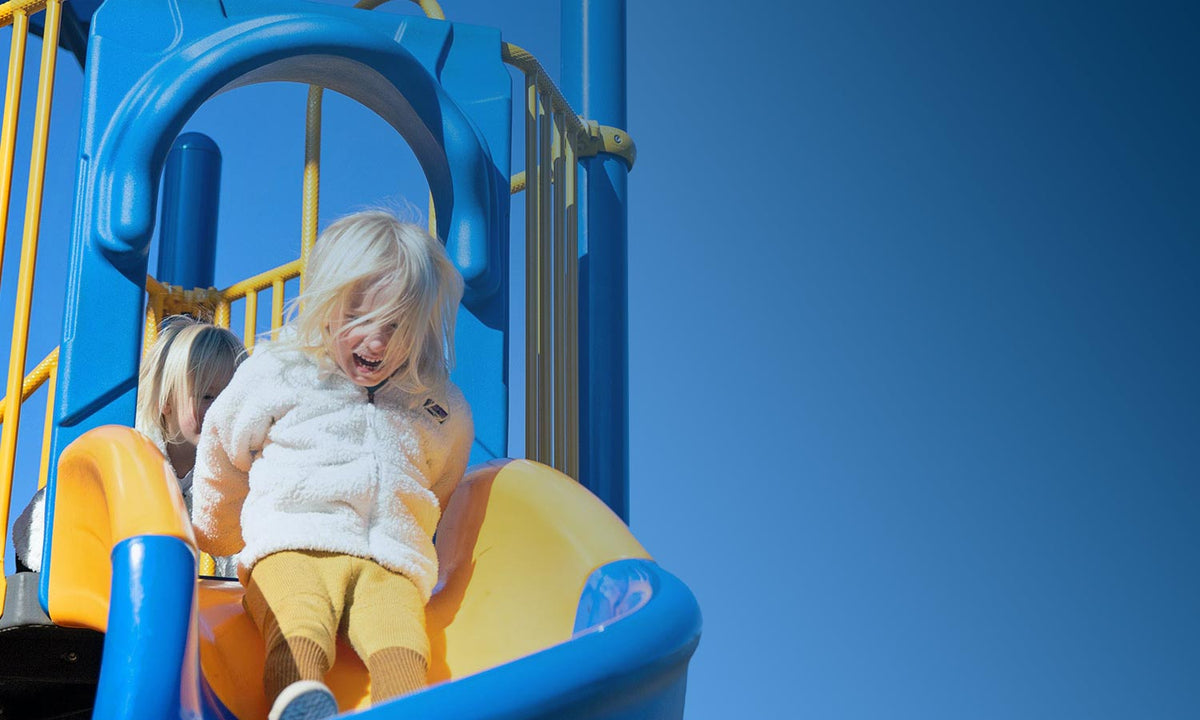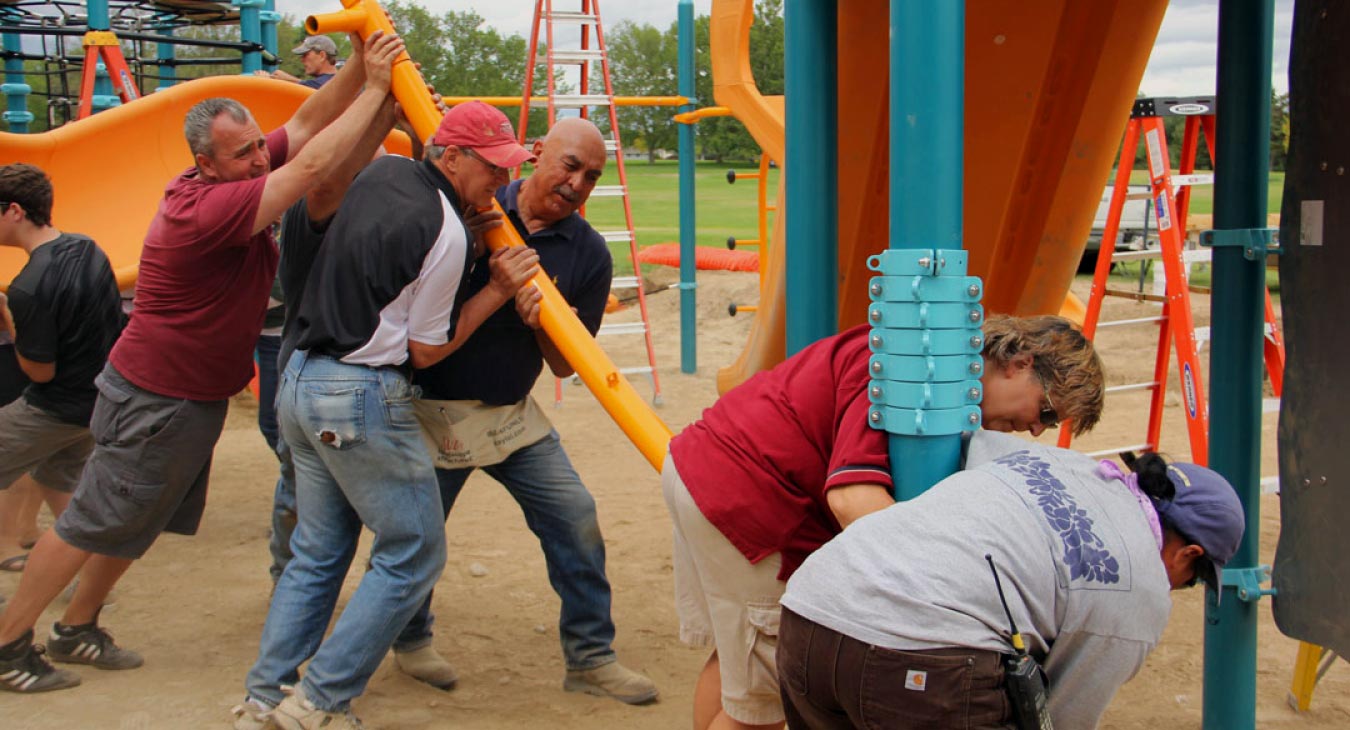Having a play set in your backyard is a great way to get your kids to play outside. With adult supervision, a backyard swingset or play structure is appropriate for most age groups.
Did you know? One of the outdoor activities that children love most is climbing.
Monkey bars, also known as a jungle gym, are a great addition to any outdoor play structure. They’re usually located near or attached to a swing set. When properly installed, they provide a sturdy structure children can enjoy while they climb the ladder rungs and swing across the overhead rungs.
Fact: The term monkey bars comes from swinging across the overhead metal rungs, which mimics the way monkeys climb and swing from trees overhead.
Here, we’ll explain the different types of monkey bars and how to properly set them up in your own backyard.
What Are the Benefits of Monkey Bars?
The physical benefits include:
- Increased outdoor activity
- Enhanced stamina & coordination
- Strength conditioning & muscle development
- Most importantly, fun with family and friends
With so many benefits, you might be wondering what options are out there. Let’s explore.
What Types of Monkey Bars Are Out There?
Straight rung horizontal ladders are what most children know as monkey bars or jungle gyms. They are made of different materials but most commonly, either metal or wood (or a combination of both).
Other monkey bar sets have wheels to climb on rather than traditional metal rungs, and come in a multitude of shapes, colors, and sizes.
The average age group of children utilizing monkey bars is between 5 and 12. Whether you’re purchasing a monkey bar set that is pre-assembled or planning to build your own, factor in the number of years you’re hoping to get out of your monkey bars when selecting the material and considering its longevity — we’ve explained this more below.
With so many different monkey bar options to choose from, there are limitless opportunities for families to create a monkey bar set up that meets their needs. Children of all ages can enjoy endless hours of monkey bar climbing fun.
What Is the Average Lifespan of Outdoor Monkey Bars?
Depending on the type of materials chosen to build outdoor monkey bars, they can last a relatively long time. The strength and durability of a metal monkey bar frame make for a longer lifespan.
If your jungle gym is made of galvanized steel or aluminum, it can last much longer, provided there is no damage where water can seep in and cause rust.
However, If you choose pressure-treated wood, it can have a longevity of 3-5 years. Wood stamped FDN is designated as a material appropriate for floor use and is a much safer option.
Borate treated lumber is the only variety considered safe for both indoors and outdoors. This is the best option because it naturally occurs in all natural things: water, soil, and minerals found in rocks.
Now, pressure-treated lumber is clearly marked. However, you’ll want to avoid wood stamped with L-P22. It’s the most toxic. It’s designed for direct contact with the ground and contains arsenic.
You will also want to avoid wood stamped with L-P2. It’s less toxic than L-P22 but is also designed for direct ground contact.
Borate protects wood from decay caused by bugs and fungus. Here’s a detailed guide to pressure-treated lumber.
With that in mind, we can now look at the best location.
What’s the Best Location for Monkey Bars?
Ideally, the best location to place monkey bars in your backyard is on a level surface. Regardless of whether or not your monkey bar frame is freestanding or anchored into the ground, you’ll want it level for safe and optimal use.
It’s also important not to place monkey bars too close to your house — so that no one accidentally hits their head when climbing. Before you purchase equipment and supplies to install your monkey bars, make sure to measure the area where they will be located.
Since monkey bars are relatively heavy, you’ll want to decide on the best spot before you start to build your backyard play structure. You won’t want to move it once you build it. A sturdy monkey bar frame on a solid surface will give your kids climbing opportunities that also ensure their safety.
Freestanding vs. Anchored Jungle Gym
Backyard jungle gyms are typically freestanding. They’re easier to break down and transport if you don’t plan to leave them in your backyard permanently. Straight rung horizontal ladders are the most popular and come in various lengths and monkey bar rung spacing.
Anchored monkey bars are most often a combination of wood and metal. A swing set and monkey bar combination can be secured by having the posts mounted into the ground and anchored by cement. Metal monkey bars can also be anchored in cement into the ground, although it’s less common.
What Type of Wood Is Used for a Wooden/Metal Monkey Bars and Swing Set?
The most durable wood types for combination metal monkey bars are the heavier varieties. Swing sets produced in China are usually composed of small, fast-growing trees. They don’t have the durability of Southern Yellow Pine, which is grown in the United States.
Make sure to inquire about what wood is used. Southern Yellow Pine holds up better against wood rot and insect decay in monkey bars that are placed outdoors.
What Kind of Pipe Do You Use for Monkey Bars?
The answer: metal monkey bar pipes are most often made of either steel or aluminum. When monkey bars are made from solid steel, the durability of steel makes it an ideal weather-resistant material – which is a perfect choice for outdoor metal monkey bars.
A wooden monkey bar ladder rung is typically made of polymer-coated wood. It’s not as sturdy as aluminum or steel rungs and usually doesn’t support more than 200 lbs.
Is a Jungle Gym or Monkey Bars Dangerous?
Adult supervision is the best way to make sure children are safe while climbing on monkey bars. Properly setting up your rungs set with a soft substrate for landing lessens the risk of injuries.
You can add materials such as shredded wood mulch, shredded rubber mulch, rubber mats, or sand to create a soft place for children to land.
It’s also important to maintain your climbing equipment and monitor for any damage, sharp edges, or rust that could cause your ladder rungs to deteriorate.
WillyGoat has many exciting configurations of playground equipment to choose from. In addition to monkey bars, they also offer a variety of wooden swing sets, slides, and rock climbing walls. The vibrant colors and exciting elements will have your children itching to play outside.
What Are the Best Types of Impact Cushioning Material to Put Under the Monkey Bars?
There are multiple options of material to create a soft surface for children to land on:
Loose-Fill Options
It should be noted that loose-fill options are a choking hazard and shouldn’t be considered for toddlers.
Shredded Rubber Mulch
Shredded rubber mulch provides the greatest impact absorption of any material. It does need to be raked sometimes to ensure even coverage. It is durable and very easy to install.
Shredded rubber comes in a nice color variety to match most landscaping. Although it costs more than wood mulch, pea gravel, or sand, it lasts longer and requires less maintenance. In fact, it might never need to be replaced.
Wood Playground Mulch
Wood playground mulch offers shock absorption, slip resistance, and drains moisture. It costs less up-front and installs easily.
It comes in a variety of colors and matches most landscapes. Wood needs to be replaced yearly and requires raking to ensure even coverage.
Pea Gravel
Pea gravel doesn’t offer the best impact absorption but does offer a little support. It gets redistributed when walked on so it will need to be raked regularly. It stays relatively clean by inhibiting the growth of microbial organisms.
While it carries a minimal up-front cost, the maintenance is hefty. It breaks down over time and will need to be replaced. The downside is that as it breaks down, it hardens – making it less desirable to break a fall.
Sand
Sand is considered to be the least effective material for impact absorption. However, it provides a low-cost option that’s very easy to install. It does attract animals and insects, which can make it unsanitary.
Sand offers a natural look that matches any landscape. Regular maintenance is required to keep it clean and safe. It’s recommended that sand be replaced at least once a year.
Solid Surface Options
Rubber Mats
Rubber mats keep bugs or sharp objects from falling in between the cracks, unlike mulch. This makes it an ideal solution to place under a monkey bar set. But remember that dark mats can absorb light and become hot to the touch in direct sunlight.
Choosing a light color will lessen the heat factor. The cost varies depending on the manufacturer but is similar to shredded rubber mulch. They have a low maintenance cost, are easy to care for and last a long time.
Grass
Grass is the least impact-absorbing option. It’s also slippery when wet and can develop uneven spots, resulting in tripping hazards. While it’s low-cost upfront, due to the ongoing maintenance, it can be costly over time.
Grass requires constant upkeep such as mowing, weeding, fertilizing, and watering. Watering the grass can also do damage to wooden structures.
What Materials & Tools Will I Need to Set Up Monkey Bars?
For anchoring your monkey bars into the ground, you will need the following:
- Posthole digger or shovel
- 2 x 50 lb. bags of concrete
- Disposable bucket for mixing concrete
- A level to ensure your monkey bars are horizontal
- Substrate mixture to go underneath the monkey bars
- An 8’ ladder
- Tape measure
Step-By-Step Guide to Setting Up Monkey Bars In Your Backyard:
Select the location to build your jungle gym.
Make sure your chosen location is level and not on a slope.
If anchoring with cement to increase strength, measure the distance between each post.
Dig each post hole.
Brace each post to make sure it’s level (you can use sticks and rocks to brace the post).
Mix the cement according to the directions on the bag.
Fill each hole with cement around each post.
Let the cement cure.
Once the cement is dry, attach the monkey bar ladder.
Using the level, make sure the air bubble is in the center to indicate that your structure is level.
Lastly, add dirt and sod (from the holes you dug earlier) around the posts.
An adult should test the monkey bars first for safety BEFORE allowing children to climb on them.
Finally, depending on what, if any, impact cushioning substance you chose, place it underneath the monkey bars.
Monkey Bar FAQs
How Do You Stabilize Monkey Bars?
Anchoring the posts in cement will keep them from moving.
How Far Apart Should the Monkey Bar Rungs Be?
Spacing should be one foot apart for optimal use.
Can I Build Monkey Bars in One Weekend?
With some DIY skills, you can easily build your monkey bars in a single weekend.
What’s Next...
Monkey bars offer children a great opportunity to unplug from technology and play with each other while using their imaginations. WillyGoat has been offering families wonderful options for their backyards for over 20 years!
Check out the incredible selection of playground equipment and toys WillyGoat has to offer. Create lasting memories with your family with your new backyard monkey bar adventure!

